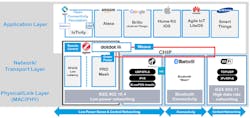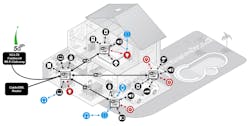Can CHIP Make the Seamless Smart Home Real?
What you’ll learn:
- The smart home has been hampered by a plethora of disparate ecosystems.
- The Zigbee Alliance’s CHIP Working Group may be the unifying force.
- How Wi-Fi 6/6E fits into the smart-home picture in the future.
With a Wi-Fi pedigree that stretches back to the “wireless LAN” days and a role in establishing both the IEEE 802.11 standards committee and the Wi-Fi Alliance, Qorvo’s Cees Links is well-positioned to opine on the future of the technology he’s so closely associated with. Today, Links is general manager of Qorvo’s Wireless Connectivity business. In this edited interview, Links discusses how the Zigbee Alliance’s nascent Project Connected Home over IP (CHIP) Working Group might catalyze convergence in the smart-home networking ecosystem.
So, how did the wireless networking ecosystem get to where it is at present?
Over the past few years, there have been many networking standards, which meant a lot of fragmentation: Wi-Fi, Bluetooth, Thread, various forms of Zigbee, and so on (Fig. 1). You see application domains, or ecosystems, such as the Open Connectivity Foundation’s IoTivity and Amazon’s Alexa. Google had Brillo and Weave, Apple had Home Kit, and Huawei was doing Lite OS. Samsung still has Smart Things.
One consequence of this fragmentation was that it kept the market waiting. The feeling over the last, say, two years, is that smart-home networking didn’t live up to expectations. On Regis McKenna’s innovation hype cycle, we landed with the IoT in the “trough of disillusionment,” and now we’re trying to climb out of it.
Late in 2019, the Zigbee Alliance launched a new Working Group called Project Connected Home over IP (CHIP). There were high expectations, and, frankly, a lot of trepidation as well… is this going to work? But after a year of significant effort, CHIP hints at what a convergence point could be (Fig. 2), with roles for Thread, Wi-Fi, Bluetooth, and the IEEE 802.15.4 radio.
The IEEE 802.15.4, Wi-Fi, and Bluetooth radios are everywhere, and CHIP, as an application-layer protocol, defines a role for all of these radio technologies. To a large extent, Bluetooth is for provisioning: If you can connect with Bluetooth to a sensor over CHIP, then your phone can become the sensor’s keyboard and screen. Now you can enter a security key for configuration or settings. When you’re happy, you can disconnect your phone from the sensor. With CHIP, you can make that sensor part of a Thread, 802.15.4, or Wi-Fi network.
So that’s the convergence point that we see being adopted in the market. Will this be only in the home? Initially, yes, but nothing is carved in stone. The industry is starting to realize that this can be a real convergence point, and other market segments, like building automation, could be very interested.
It sounds like a good vehicle for a lot of disparate devices to talk to each other.
Yeah, now my fridge can talk with my toaster. But there are more interesting problems to solve. My living room has three motion sensors: one each for the lighting, security system, and HVAC. Why? Because there are three ecosystems. We’re looking to understand how we can use the IoT and what we expect from certain sensors, controllers, and actuators. It’s not about radios or protocols, but about applications that can work together and use data from each other. It requires a sort of openness that the industry is slowly growing into.
Consumers want data from sensors or devices to be shared with other devices doing other applications, and CHIP enables this. Whether it happens depends on Google, Amazon, Apple, and Samsung making data available from their respective devices to be used by applications in the others’ devices.
I don’t know if having my toaster and fridge talking is useful, but if they did, it would have to be in the ecosystems above the communication layer. If the communication layers don’t talk to each other, though, then the layers above will do so even less. From that perspective, I think CHIP is a great step forward and that the industry is really starting to coalesce behind it. If Amazon and Google want it to happen, it will happen.
How might this work in an industrial environment?
Consider Wi-Fi, which, initially, was good for consumers. But companies and enterprises, let alone industries, would never adopt Wi-Fi because it was a consumer technology that lacked the required reliability and stamina. Over time, you had enterprise-hardened Wi-Fi, and Power over Ethernet makes enterprise installations very easy. But the industrial environment is extremely conservative and slow in adopting new standards. So, it’s a matter of time. Frankly, it may be about a decade out.
The big question is where does this leave Zigbee as we know it today? First, the Zigbee Alliance and its members have realized that something must give to get to one worldwide standard. Over time, Zigbee will fade away. Zigbee’s core technologies have largely been implemented in CHIP, including the dotdot cluster library. Many Zigbee Alliance members also participate in the Thread Alliance, which has been working to get the dotdot cluster library running under Thread. So, for the participants, it’s quite a natural migration.
The Bluetooth situation is even more dynamic and interesting. The Bluetooth Alliance is adding meshing capability to compete with CHIP and Zigbee. But the Bluetooth people must realize that Zigbee’s meshing is already harmonized under CHIP as well. I expect that Bluetooth Mesh will wither away. Because Bluetooth’s Profiles are equivalent to the dotdot cluster library in Zigbee, phones will still have Bluetooth Profiles. But Bluetooth’s role in CHIP will become purely one of provisioning.
With CHIP, we’ll start seeing some unification, and the fight between Zigbee, Thread, and Bluetooth Mesh will disappear. Eventually, it will propagate from the Connected Home to Connected Buildings and Connected Industries.
Will the Zigbee Alliance continue to maintain and administer it?
Yes, for the time being, Zigbee is still out there and there’s no need to move away from Zigbee as such. But will there be a next-generation Zigbee Pro 2.x? I can’t speak for the Alliance, but I expect that all future development will be on top of CHIP rather than Zigbee.
Ultimately, everything depends on the ecosystems sharing their data. Until that happens, I’ll still need three sensors for HomeKit, Google Home, and Amazon Alexa. All three sensors probably work with CHIP, and with Thread, and with 802.15.4. But if the data isn’t shared, I still have multiple apps on my phone. That’s the way you can see it as well.
Standardization starts at the bottom and is slowly crawling up into the value chain. Now, the challenge for the ecosystems is to find a profitable way to share data so that it becomes a rising tide that floats all the boats.
How do Wi-Fi 6 and 6E fit into the picture as we move forward?
We see the world as divided between outdoors and indoors. Outdoors, we use cellular connectivity, with subscriptions and SIM cards. Indoors, we use Wi-Fi, where there are no SIM cards but there’s limited range, basically throughout the home. At home, I use my own network and router, my own connectivity, so to speak.
When I’m on the road, I use the cellular infrastructure, so I need a subscription for that. Now, of course, things start blurring, because you need a subscription to get the internet to your front door, but not necessarily throughout your house.
In the past, you had one router at the front door. If you wanted a strong signal throughout the house, you had to install repeaters and fiddle around. The key to Wi-Fi 6, especially now that we all work from home, is that it’s a distributed architecture (Fig. 3). You’ll go to Best Buy and pick up a Wi-Fi 6 router that will come with two to four satellites. All of these satellites are configured to talk with each other in one network with one ID, one password. That’s the starting point for Wi-Fi 6.
Why is this so relevant to the IoT? One of Zigbee’s selling points is meshing, but with Wi-Fi 6, Wi-Fi meshing covers the entire home. We believe that in the future, Zigbee (or, if you like, CHIP) meshing will become redundant and wither away. Instead, every CHIP device can find an integrated Wi-Fi/CHIP device in the house and be connected via that device to the network.
In the future, a Wi-Fi pod in a room will connect all devices in the room, but you can also imagine the other way around. My wife hates seeing a router in a room, but if it’s built into something like the NetGear Meural digital art canvas, she wouldn’t care. Televisions can operate as a Wi-Fi pod, surf all of the devices in the living room, and be itself connected via Wi-Fi to the router. So, there’s an interesting kind of future morphing, I like to say, turning things inside out.
The main static devices in the house become Wi-Fi pods for the whole home. Amazon Alexa, or Dot, or a Google device, can function as Wi-Fi pods. The devices will start to absorb the pods and become part of the infrastructure themselves.
That’s our vision of Wi-Fi and how IoT/CHIP will merge. Then, there’s also Wi-Fi 6E. For 20 years, Wi-Fi has been running on 2 GHz and 5 GHz, but they’re running into a wall. Wi-Fi 6E, with the tremendous amount of 6-GHz bandwidth it brings, will open things up again.
Can Wi-Fi and 5G coexist?
My expectation is that Wi-Fi and 5G will continue to coexist, because it’s just so close to how people perceive networking and connectivity. Indoors, in your house, with your own network and spectrum, no SIM card is required. And outdoors, with your phone, you need the infrastructure.
I think Bluetooth will also have a long life, because it’s a third psychological experience, so to speak. There’s indoors and outdoors, and the third experience is what I call the personal bubble. Bluetooth is the connectivity for your bubble. It connects your watch to your phone, your headphones to your phone; you can do all kinds of things in your personal bubble. If I’m on my bicycle, then the speedometer is in my personal bubble, connected by Bluetooth.
So, all of these things, in my personal bubble, are connected. And that’s a third radio. In a way, I see Wi-Fi and CHIP merging as indoor wireless technology in license-free spectrum. I see 5G out there and Bluetooth out there. Of course, there will be new technologies and ideas. Nothing is static in this world. But there’s some logic in the three radios that we’re used to in our phones: a personal bubble, a local home network, and an outdoor 5G subscription network. And the three will coexist in one device.
About the Author
David Maliniak
Executive Editor, Microwaves & RF
I am Executive Editor of Microwaves & RF, an all-digital publication that broadly covers all aspects of wireless communications. More particularly, we're keeping a close eye on technologies in the consumer-oriented 5G, 6G, IoT, M2M, and V2X markets, in which much of the wireless market's growth will occur in this decade and beyond. I work with a great team of editors to provide engineers, developers, and technical managers with interesting and useful articles and videos on a regular basis. Check out our free newsletters to see the latest content.
You can send press releases for new products for possible coverage on the website. I am also interested in receiving contributed articles for publishing on our website. Use our contributor's packet, in which you'll find an article template and lots more useful information on how to properly prepare content for us, and send to me along with a signed release form.
About me:
In his long career in the B2B electronics-industry media, David Maliniak has held editorial roles as both generalist and specialist. As Components Editor and, later, as Editor in Chief of EE Product News, David gained breadth of experience in covering the industry at large. In serving as EDA/Test and Measurement Technology Editor at Electronic Design, he developed deep insight into those complex areas of technology. Most recently, David worked in technical marketing communications at Teledyne LeCroy, leaving to rejoin the EOEM B2B publishing world in January 2020. David earned a B.A. in journalism at New York University.




